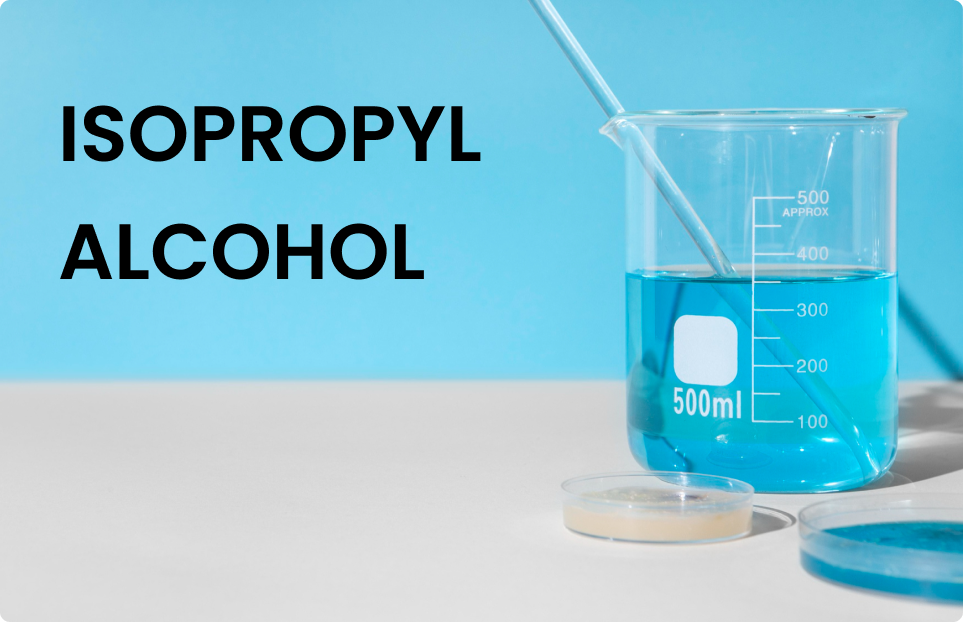
June 27, 2024
Isopropyl Alcohol: The Ultimate Guide to Understanding and Using This Versatile Liquid
Isopropyl alcohol, also known as 2-propanol or isopropanol, is a colorless, flammable liquid with a strong odor. It is a versatile chemical with a wide range of applications in various industries. In this blog post, we will explore the basic information, industrial applications, emerging applications, production processes, and the future outlook of isopropyl alcohol.
Basic Information
Isopropyl alcohol has the chemical formula C3H8O and a molar mass of 60.10 g/mol. It is a secondary alcohol, meaning that the hydroxyl group (-OH) is attached to a carbon atom that is also bonded to two other carbon atoms. Isopropyl alcohol is miscible with water and many organic solvents, making it a useful solvent and cleaning agent.
Primary industrial applications of isopropyl alcohol:
Cleaning Agent: Isopropyl alcohol is widely used as a cleaning solvent to remove grease, oil, and other contaminants from surfaces. It is commonly used for cleaning electronic components, optical lenses, and other precision equipment. Isopropyl alcohol is also used in household and industrial cleaning products, such as disinfectants, degreasers, and glass cleaners. IPA is widely used as a cleaning solvent and degreaser in the coatings industry, particularly for cleaning equipment, surfaces, and removing contaminants. The high solvency and fast evaporation rate of IPA make it effective for these cleaning applications.
Solvent: Isopropyl alcohol serves as a solvent in various industries, including paints, inks, cosmetics, and
Pharmaceuticals: It is used to dissolve and disperse a wide range of organic compounds. In the pharmaceutical industry, isopropyl alcohol is used as a solvent for active ingredients and excipients.
Antiseptic: Isopropyl alcohol is used as an antiseptic and disinfectant in medical and personal care products.
It is effective in killing bacteria, viruses, and fungi, making it a common ingredient in hand sanitizers, wound cleansers, and other disinfecting solutions.
Fuel Additive: Isopropyl alcohol is added to gasoline and other fuels to improve combustion and reduce emissions.
It can enhance the octane rating and help prevent the formation of deposits in fuel systems.
Chemical Intermediate: Isopropyl alcohol is used as a chemical intermediate in the production of other organic compounds, such as acetone and isopropyl esters. These derivatives find applications in various industries, including pharmaceuticals, cosmetics, and plastics.
Ink Formulations: Isopropyl alcohol is used as a solvent in the formulation of printing inks, particularly in the packaging and industrial printing sectors. The ability of IPA to dissolve and disperse a wide range of organic compounds makes it valuable in ink compositions.
Miscellaneous Applications: Isopropyl alcohol is used in the manufacture of certain pharmaceuticals, cosmetics, and personal care products. It is also employed as a coolant and heat transfer fluid in various industrial processes. The versatility of isopropyl alcohol, combined with its effectiveness as a solvent, cleaning agent, and disinfectant, has made it an essential industrial chemical with a wide range of applications across multiple sectors.
Emerging Applications
In addition to its traditional uses, isopropyl alcohol is finding new applications in emerging fields:
Hand sanitizers: The COVID-19 pandemic has significantly increased the demand for isopropyl alcohol in hand sanitizers.
Disinfectant wipes: Isopropyl alcohol is a key ingredient in disinfectant wipes used for cleaning and sanitizing surfaces.
Biofuel: Researchers are exploring the use of isopropyl alcohol as a potential biofuel or fuel additive.
Traditional Production Process
Isopropyl alcohol is primarily produced through the indirect hydration of propylene. This process involves the following steps:
- Propylene is reacted with sulfuric acid to form isopropyl sulfate.
- The isopropyl sulfate is then hydrolyzed with water to produce isopropyl alcohol and regenerate sulfuric acid.
Emerging Production Processes
While the traditional production process remains widely used, there are also emerging methods for producing isopropyl alcohol:
Biotech-based production: Researchers are investigating the use of microorganisms or enzymes to produce isopropyl alcohol from renewable feedstocks, such as agricultural waste or biomass.
Catalytic processes: New catalytic technologies are being developed to improve the efficiency and selectivity of the hydration step, potentially reducing waste and energy consumption.
Future Outlook
The future outlook for isopropyl alcohol is promising, with continued demand in existing applications and potential growth in emerging markets. However, the industry also faces challenges, such as regulatory restrictions and the need for more sustainable production methods. As industries prioritize green chemistry and reducing environmental impact, the long-term outlook for isopropyl alcohol may depend on the industry’s ability to develop safer, more sustainable alternatives and production methods.
Conclusion
Isopropyl alcohol is a versatile chemical with a wide range of applications across various industries. While traditional uses remain strong, emerging applications in hand sanitizers, disinfectant wipes, and biofuels are driving increased demand. As the industry continues to evolve, the focus on sustainability and green chemistry will shape the future of isopropyl alcohol production and usage.


